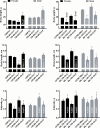Body Composition QTLs Identified in Intercross Populations Are Reproducible in Consomic Mouse Strains
- PMID: 26551037
- PMCID: PMC4638354
- DOI: 10.1371/journal.pone.0141494
Body Composition QTLs Identified in Intercross Populations Are Reproducible in Consomic Mouse Strains
Abstract
Genetic variation contributes to individual differences in obesity, but defining the exact relationships between naturally occurring genotypes and their effects on fatness remains elusive. As a step toward positional cloning of previously identified body composition quantitative trait loci (QTLs) from F2 crosses of mice from the C57BL/6ByJ and 129P3/J inbred strains, we sought to recapture them on a homogenous genetic background of consomic (chromosome substitution) strains. Male and female mice from reciprocal consomic strains originating from the C57BL/6ByJ and 129P3/J strains were bred and measured for body weight, length, and adiposity. Chromosomes 2, 7, and 9 were selected for substitution because previous F2 intercross studies revealed body composition QTLs on these chromosomes. We considered a QTL confirmed if one or both sexes of one or both reciprocal consomic strains differed significantly from the host strain in the expected direction after correction for multiple testing. Using these criteria, we confirmed two of two QTLs for body weight (Bwq5-6), three of three QTLs for body length (Bdln3-5), and three of three QTLs for adiposity (Adip20, Adip26 and Adip27). Overall, this study shows that despite the biological complexity of body size and composition, most QTLs for these traits are preserved when transferred to consomic strains; in addition, studying reciprocal consomic strains of both sexes is useful in assessing the robustness of a particular QTL.
Conflict of interest statement
Figures

Similar articles
-
Loci on chromosomes 2, 4, 9, and 16 for body weight, body length, and adiposity identified in a genome scan of an F2 intercross between the 129P3/J and C57BL/6ByJ mouse strains.Mamm Genome. 2003 May;14(5):302-13. doi: 10.1007/s00335-002-2170-y. Mamm Genome. 2003. PMID: 12856282 Free PMC article.
-
QTL for body composition on chromosome 7 detected using a chromosome substitution mouse strain.Obesity (Silver Spring). 2008 Feb;16(2):483-7. doi: 10.1038/oby.2007.26. Obesity (Silver Spring). 2008. PMID: 18239664 Free PMC article.
-
Exercise and diet affect quantitative trait loci for body weight and composition traits in an advanced intercross population of mice.Physiol Genomics. 2012 Dec 1;44(23):1141-53. doi: 10.1152/physiolgenomics.00115.2012. Epub 2012 Oct 9. Physiol Genomics. 2012. PMID: 23048196 Free PMC article.
-
Complex quantitative traits cracked by the mouse inter-subspecific consomic strains.Exp Anim. 2012;61(4):375-88. doi: 10.1538/expanim.61.375. Exp Anim. 2012. PMID: 22850637 Review.
-
PLAG1 and NCAPG-LCORL in livestock.Anim Sci J. 2016 Feb;87(2):159-67. doi: 10.1111/asj.12417. Epub 2015 Aug 11. Anim Sci J. 2016. PMID: 26260584 Free PMC article. Review.
Cited by
-
Genetic controls of Tas1r3-independent sucrose consumption in mice.Mamm Genome. 2021 Apr;32(2):70-93. doi: 10.1007/s00335-021-09860-w. Epub 2021 Mar 12. Mamm Genome. 2021. PMID: 33710367
-
Burly1 is a mouse QTL for lean body mass that maps to a 0.8-Mb region of chromosome 2.Mamm Genome. 2018 Jun;29(5-6):325-343. doi: 10.1007/s00335-018-9746-7. Epub 2018 May 8. Mamm Genome. 2018. PMID: 29737391
-
Identification of mutations through dominant screening for obesity using C57BL/6 substrains.Sci Rep. 2016 Sep 2;6:32453. doi: 10.1038/srep32453. Sci Rep. 2016. PMID: 27585985 Free PMC article.
-
Adiposity QTL Adip20 decomposes into at least four loci when dissected using congenic strains.PLoS One. 2017 Dec 1;12(12):e0188972. doi: 10.1371/journal.pone.0188972. eCollection 2017. PLoS One. 2017. PMID: 29194435 Free PMC article.
References
-
- Godfrey P, Rahal JO, Beamer WG, Copeland NG, Jenkins NA, Mayo KE. GHRH receptor of little mice contains a missense mutation in the extracellular domain that disrupts receptor function. Nat Genet. 1993;4(3):227–32. . - PubMed
-
- Zhang Y, Proenca R, Maffei M, Barone M, Leopold L, Friedman JM. Positional cloning of the mouse obese gene and its human homologue. Nature. 1994;372(6505):425–32. . - PubMed
Publication types
MeSH terms
Grants and funding
LinkOut - more resources
Full Text Sources
Other Literature Sources
Medical
Molecular Biology Databases
Research Materials
Miscellaneous

